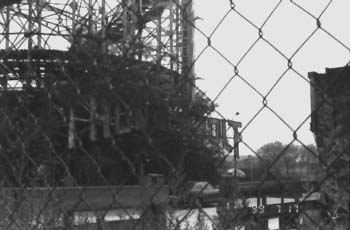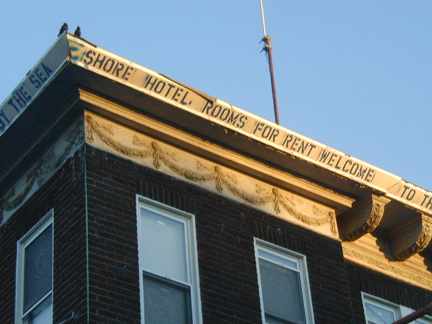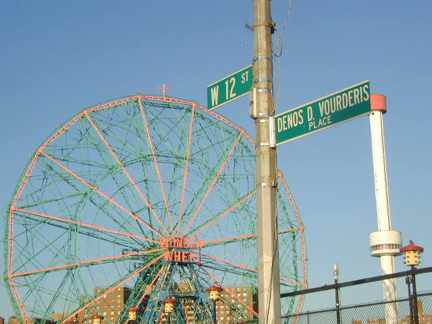Coney Island, once America’s summer playground, has become just a shadow of its former self, despite grand plans for a new subway terminal here, or a new minor league ballpark there.
I enjoy going to Coney in the winter, when there’s no one else around. I look for traces of Coney’s former glory. If you search hard enough, you’ll find ample evidence of what Coney used to be like.
Thunderbolt’s Last Days
1925 postcard of the then brand-new Thunderbolt
Yes, there actually used to be a house under the now-demolished Thunderbolt roller coaster in Coney Island. Actually, the house, which used to be the Kensington Hotel, was built in 1895 and the Thunderbolt was built over it! The situation was memorialized in Woody Allen’s movie Annie Hall. The last owner of the housewas the coaster’s owner, Fred Moran; a friend, Mae Timpano, occupied the house till 1988 when the property was sold to developer Horace Bullard. A caretaker occupied the house until amost the day of demolition! The Thunderbolt closed for business in 1983.
The once-bustling Steeplechase area is now the home of the Brooklyn Cyclones.
11/2000: The Thunderbolt is no more; it was torn down in fall 2000. Apparently it was deemed too unstable to remain standing any longer (though depending on who you believe, Mayor Giuliani wanted it torn down because developers of the adjacent Mets’ minor league park considered it an eyesore). It was built by famed roller coaster designer John Miller in 1925, so the structure lasted an even 75 years.
Someone thought to put an American flag on one of the windows of the now-abandoned Kensington Hotel. Roller coaster and flag are now gone for good.
The Thunderbolt’s neon sign on Bowery Street survived till the end.
A pair of Thunderbolt pics from May 2000 by Forgotten Fan Tom Traegler.
Winter view of the Coney Island beach. The Steeplechase Pier can be seen in the background. Fluke, bluefish and bass can be caught from the pier.
The former Childs Restaurant on the Boardwalk. Friezes of sailing ships and King Neptune adorn the tops of the arches; the roof is intricately decorated with carvings of fish. The graffiti seen here has recently been painted over! Child’s, which used to be a bustling NYC franchise with restaurants all over, built the ornate restaurant in 1924. It served as a firebreak during the Coney Island Fire of 1932 and saved other buildings from destruction.
The Coney Island Parachute Jump was built for the 1939-40 World’s Fair in Flushing Meadows and was moved to Coney Island after the Fair closed. It was still open well into the 1960s. The structure is visible from along the Brooklyn shore as far as Bay Ridge. Can you imagine riding to the top and floating back down, as thousands used to do decades ago? I can’t.
Life Savers Candy was an original sponsor of the ride at the ’39-40 World’s Fair.
Note the moon rising to the left of the parachute jump in the photo on the left.
Herman Popper and his brother built this building as a distillery and later, a tavern in 1904 on Surf Avenue near Stillwell. By 1999, it had been assaulted by garish signing proclaiming the existence of a Carvel “ice cream bakery” (and I’d love to have some baked ice cream.)
By 2002, an art gallery occupied the top floor.
Next to the Faber game palace and the Kennedy Fried Chicken joint was the Surf Hotel, marked by this neon sign.
Next door, the Shore Hotel was in operation almost to the date of its demolition in 2010. The corner building housing Kennedy Fried Chicken, Faber’s and the Surf Hotel was demolished in late 2010-early 2011.
Originally a theater featuring live shows and first-run movies, the Loew’s Theater, built in the 1920s, featured a Nedicks on the ground floor and offices on the upper floors. It was once the second tallest building in Coney Island, next to the now-demolished Half Moon Hotel. Both were surpassed by high rise housing in the 1950s.
By the 1970s, Loew’s, by then known as the Shore, was home to X-rated grindhouse films. Nedicks gave way to a succession of busineses like the Gayway Bar and Grill and Kansas Fried Chicken; these days, not much is happening with the place.
Childs restaurant also had a branch on Surf Avenue. When West 12th Street was cut through in 1921 the building was moved 20 feet to the west. Much of its original 1917 molding remains intact, but the ground-floor arches that were there when it was a restaurant have long been removed.
A hardware store for over 60 years, this building was built by Henry Grashorn in the late 1880s. Its shingles, clapboard siding and dormer windows have all been removed; only its original mansard roof can be made out.
Denos Vourderis purchased the Wonder Wheel from the family of the original owner in 1983. His sons Steve and Dennis run the park presently.
Milton Berger was a Coney Island publicist from the 1950s-1970s; he coined the phrase, “The great days of Coney Island are in the future.”
Dewey Albert was the co-crerator of Astroland Amusement Park, which opened on the site of the old Feltmans Restaurant in 1963.
2011: Except for Childs, much of Coney Island is slated for redevelopment. The Wonder Wheel is safe but Astroland was replaced by the new Luna Park in 2010.
Coney Island Walking Tour, Charles Denson, 1998 Dreamland Press
Coney Island Lost and Found, Charles Denson, 2003 Ten Speed Press
BUY this book at Amazon.COM
12/30/98; updated 9/26/11



















